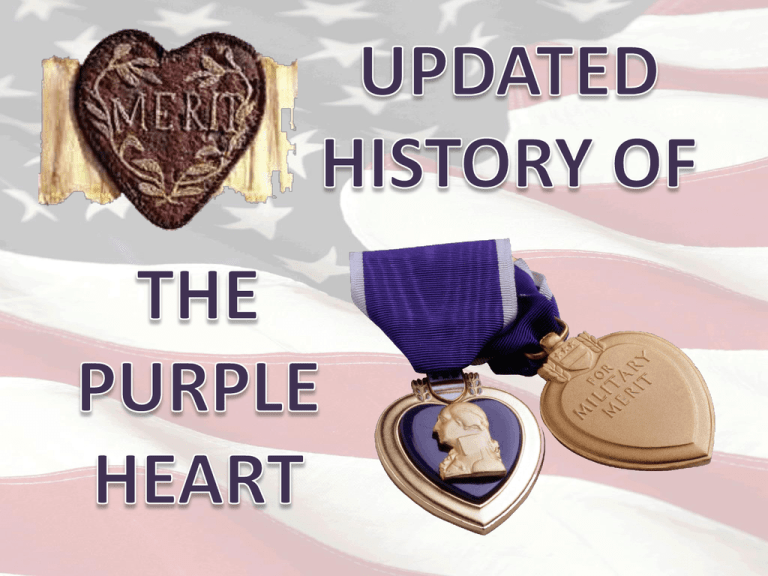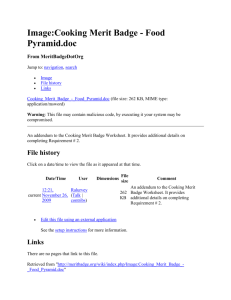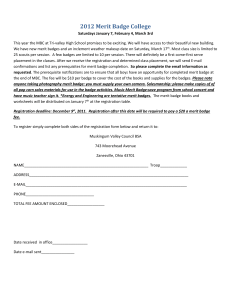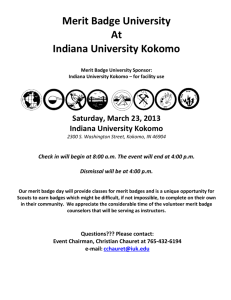Powerpoint - Military Order of the Purple Heart
advertisement

The Badge of Military Merit is the oldest known United States military decoration still in use. However, there was one other decoration awarded to members of the Continental Army that pre-dated even the Badge of Military Merit. The Fidelity Medallion or “Andre Capture Medal,” was created by act of the Continental Congress in 1780. It was awarded to Privates John Paulding, David Williams and Isaac Van Wart of the New York State Militia. On the obverse is what appears to be a heart, flanked by leafed stalks, with “Fidelity” above. The reverse contains the Latin phrase, Amor Patriae Vincit, “Love of Country Conquers.” It never was awarded again, so the award created two years later by General George Washington is often considered the oldest. WHY THE ANDRE CAPTURE MEDAL ? Major John Andre was a British army officer hanged as a spy during the American Revolutionary War for assisting Benedict Arnold to surrender the fort at West Point, New York to the British Army. On September 23, 1780, after meeting with Benedict Arnold, Andre passed near Tarrytown, New York, where three militiamen stopped and arrested him, finding plans of West Point and letters from Arnold hidden on his person. André appealed to George Washington to be executed by firing squad, but by the rules of war he was hung as a spy at Tappan, New York on October 2, 1780. The names of André's captors were John Paulding, David Williams, and Isaac Van Wart. The United States Congress gave each of them a pension of $200 a year and a silver medal, known as the Fidelity Medallion. All were later honored in the names of counties in Ohio, and in 1853 a monument was erected to their memory on the place where they captured André. No other soldiers were ever awarded the Fidelity Medallion. By April 1782, General Washington had established his Head Quarters at Newburgh, New York to keep watch on British forces in New York. He also needed to consolidate the 7,000 man Continental Army and quell a threatened mutiny over pay and pensions. For his soldiers, he wanted to continue efforts to improve their condition and morale. General Washington’s personal writings indicate that three badges, two Honorary Badges of Distinction and a Badge of Military Merit, were created on August 7, 1782. The practice in Europe was to honor high-ranking officers who had achieved victory, rather than common soldiers. But in America, as General Washington said, the "road to glory in a patriot army and a free country is…open to all. Of the Badge of Military Merit, Washington wrote: "The General ever desirous to cherish a virtuous ambition in his soldiers, as well as to foster and encourage every species of Military Merit, directs that whenever any singularly meritorious action is performed, the author of it shall be permitted to wear on his facings over the left breast, the figure of a heart in purple cloth or silk, edged with narrow lace or binding. Not only instances of unusual gallantry, but also of extraordinary fidelity and essential service in any way shall meet with a due reward". General George Washington On August 31, 1782 the Providence Gazette & Country Journal made the first public reporting of George Washington's General Order creating the "Honorary Badge of Distinction and the Badge of Military Merit.” One of only two known surviving original and complete historical heirloom newspapers is in the possession of James Klug, MOPH Department Commander and Stephanie Klug, Ladies Auxiliary Unit 147, Medford, Oregon. RECIPIENTS Most historians indicate that only three people received the Badge of Military Merit during the American Revolutionary War, all of them noncommissioned officers, and the only ones who received the award from General Washington himself. Those soldiers are as follows: On May 3, 1783 Sergeant William Brown 5th Connecticut Regiment of the Connecticut Line Sergeant Elijah Churchill 2nd Continental Light Dragoons On June 10, 1783 Sergeant Daniel Bissell 2nd Connecticut Regiment of the Connecticut Line OTHER RECIPIENTS While researching the Purple Heart Medal at the National Archives, National Americanism Officer Ron Siebels discovered that while these three soldiers were most likely the first to receive the Badge of Military Merit, discharge certificates of other Revolutionary War soldiers indicate that they also received the "Badge of Merit" for their years of faithful service. John Sithins Fife 2nd New Jersey Regiment discharged June 5, 1783 John Sithins discharge document was signed by George Washington on June 5, 1783. Additional documents at the National Archives support the authenticity of George Washington’s signature. The last three lines at the bottom of the page read “The above Fifer John Sithins has been honored with the Badge of Merit for seven years faithful service.” Peter Shumway Soldier 4th Massachusetts Regiment discharged June 9, 1783 In a pension claim by his heirs following his death on June 7, 1832, The Honorable W.P. Waldo, Commissioner of Pensions, certified that Peter Shumway, a soldier in the 4th Massachusetts Regiment, was discharged with the Badge of Merit for six years faithful service on June 9, 1783. William Dutton Sergeant 7th Massachusetts Regiment discharged June 10, 1783 The actual discharge certificate of Sergeant William Dutton certifies his faithful service for seven years and five months and discharge on June 10, 1783. On the document, Lt. Col. J. Brooks, Commander of the 7th Massachusetts Regiment, certifies that Sergeant William Dutton has been honored with the Badge of Merit for seven years faithful service. Under the auspices of the National Americanism Program The Military Order of the Purple Heart continues to research the origins and history of the Badge of Military Merit and the Purple Heart Medal in honor of those who have sacrificed their lives or well being in the service of their country.











